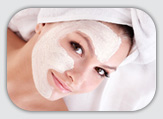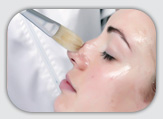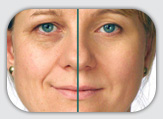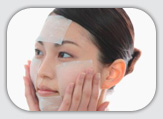The skin is composed of the epidermis and the dermis. Within the dermis are two layers, both of which are constructed of collagen, long fibers that loosen and stretch with age and sun damage. If the deepest layer, the reticular layer, is damaged, scars result, while the upper layer of the dermis, the papillary layer, heals from injuries without scarring. In a chemical peel, the surgeon applies one of several chemicals to the skin. Glycolic acid is the mildest. TCA, trichloroacetic acid, can be used in varying strengths for longer-lasting smoothness. The deepest peel is done with phenol.
Before any peel, the face is first thoroughly cleansed with a solution to remove oil and to prepare the skin for deepest penetration. As the chemical is applied, the epidermis is removed, and the chemical penetrates into the first layer of the dermis.
There are many types of peels prescribed by Dr. Rathindra Nath Dutta, which can sometimes be used together to bring the best results:
 1. GLYCOLIC PEEL (MILD PEEL) 1. GLYCOLIC PEEL (MILD PEEL)
Glycolic Acid is a natural substance derived from sugar cane that gently dissolves the glue like substance that holds dead skin cells onto the surface of the skin. Glycolic peels come in a variety of strengths from an at home 5% peel to a salon strength of 20 or 40% up to a medical strength of 70 – 90% that should only be performed by a doctor or nurse. You may feel a slight stinging or warming sensation during the procedure but any significant pain is unlikely and no anaesthetic is needed for a mild peel.
 2. SALICYLIC PEELS 2. SALICYLIC PEELS
Salicylic Peels are usually at a strength of 20% or 30% and regular peels with salicylic acid will remove blackheads and whiteheads, diminish fine lines and wrinkles and improve acne resulting in smoother and more even toned skin.
Beta hydroxy acids work in a similar way to AHAs – allowing dead skin cells to be detached from the skin’s surface. The main benefit of salicylic acid is that as it has similar properties to aspirin, it helps prevent any post-treatment irritation or inflammation and helps to prevent excess oil making it highly effective in the treatment of acne skin.
 3. TCA PEEL 3. TCA PEEL
TCA stands for Trichloroacetic Acid, which is derived from the acid that gives vinegar its pungent smell and taste. It is a medium to deep peeling agent that is normally used in 10 to 35% concentrations.This can be a painful peel where the skin blanches (frosts and turns white), but works well for specific skin conditions. A topical anaesthetic or pain relief will be administered to help you stay comfortable during the treatment.
The peel works by causing trauma to the skin’s layers and the top layer of the epidermis may be removed, where stronger solutions are used the treatment may extend deeper into the dermis. The damaged layers of skin will peel away and the healing process encourages increased cell growth as well as collagen production and reorganization in the dermis that produces new, healthier skin layers, giving the face a more youthful, rejuvenated appearance.

4. MULTI MASK PEEL
A Multi Mask Peel uses a form of Kojic Acid that is found in Japanese Sake and shitake mushrooms, to re-new the surface of the skin in a way that eliminates pigmentation problems.
5. MODIFIED JESSNER PEEL
A fantastic skin peel for Acne and Acne Scarring and Pigmentation
|